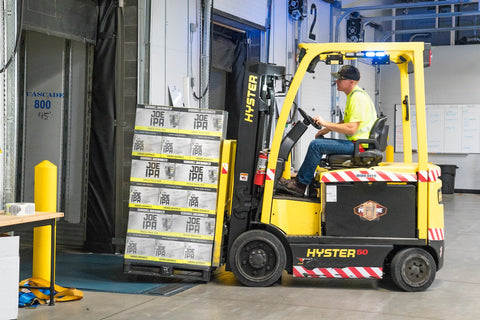So You Bought an Empty Warehouse… Now What?
Opening the doors on a completely empty building is thrilling—and daunting. Global demand for modern logistics space keeps climbing: analysts expect the warehousing market to reach $869 billion in 2025, with roughly 180,000 facilities worldwide. In the U.S., e-commerce alone will push warehouse leasing past 800 million ft², and 3PLs are projected to drive about 35 % of that activity.
If you’re one of those new owners, use this step-by-step roadmap to go from four empty walls to a fully humming fulfillment center—without costly missteps.
1. Sketch the Master Plan (Layout)
- Flow first → Put receiving and shipping on opposite sides in a U-shape if returns are heavy; use an L-shape when pick lines dominate.
- Slot fast-movers up front. Reduce pick paths before you automate.
- Design for 10-year growth. Reserve 10–15 % of floor space for future mezzanines or automation cells.
Tool: Layout simulators such as AnyLogistix or SmartDraw let you drag pallets, racks, and equipment to test flow before a single anchor drops.
Related reading → The Power of Organized Shelving Units
2. Equip for Efficiency - Only What You Need, Day 1
| Essential Day-1 Gear | Why It Matters | When to Upgrade |
|---|---|---|
| Pallet jacks & hand trucks | Lowest-cost way to move pallets and cartons | Swap for narrow-aisle forklifts once SKUs exceed 2,500 |
| Stretch-wrap station | Secures outbound pallets; reduces OS&D claims | Automate when daily pallet count > 150 |
| Cloud WMS | Real-time inventory & barcode scanning | Add labor-management modules when headcount > 25 |
Tip: Lease forklifts the first 12 months; capital is better spent on slotting software that raises pick productivity faster than new hardware.
3. Choose Storage That Scales
- Plastic Bins & Totes — start with rugged, stackable extra-large bins for bulk parts, then graduate to pick-racks.
- Wire or Polymer Shelving — 600 lb capacity per shelf is usually enough. Epoxy-coated shelving units resist humidity if the space isn’t climate-controlled.
- Cart-based Micro Zones — wheel inventory to pop-up pack stations during peak season.
Unsure which container style fits best? See Choosing Warehouse Containers for a quick decision tree.

4. Build Your Fulfillment Tech Stack
- WMS + Barcode – 90% of warehouses will either deploy or expand WMS by 2025.
- Printers & Scales at Every Pack Station – shaving 45 seconds per order adds up fast.
- Future-proof for Automation – keep 12 ft of clear height above main aisles for mini-load shuttles or AMRs; robots can cut labor 25-30%.
5. Hire, Train, and Retain
- Right-size the crew. Start with 1 picker per 30–40 orders/hour; add temp labor only when spikes exceed 25%.
- Cross-train. Every team member should master at least two zones—flexes labor up to 15%.
- Safety first. OSHA citations topped $48 M last year; daily stretch breaks and PPE audits are cheaper than fines.
Need a refresher on bin-based pick zones? Compare options in Shelf Bin Organizers.
6. Go Live with Crystal-Clear SLAs
| SLA Component | Best-Practice Target |
|---|---|
| Cut-off time | Orders in by 3 PM ship the same day |
| Dock-to-Stock | < 4 hours for palletized goods |
| Order Accuracy | ≥ 99.6 % (2025 WERC median) |
Post the SLA scorecard in the break-room—nothing motivates like seeing yesterday’s miss rate.
Further Reading
- Material Handling: What It Is & Why It Matters
- Benefits of Using Stackable Storage Bins
- Ultimate Guide to Workshop Storage Solutions
- 10 Benefits of Using Storage Bins in Your Warehouse
- Guide to Choosing Warehouse Containers
- Use Cases for Open Front Plastic Bins
- Warehousing & Distribution: Using Plastic Parts Bins
- Most Popular Bins & Containers for Warehouse Use
Key Takeaway
Treat the empty building like a startup: iterate quickly, invest only in assets that raise velocity, and keep every square foot accountable to revenue. When you’re ready to add the bins, shelving, and pick racks that grow with you, Industrial 4 Less is here to help.





